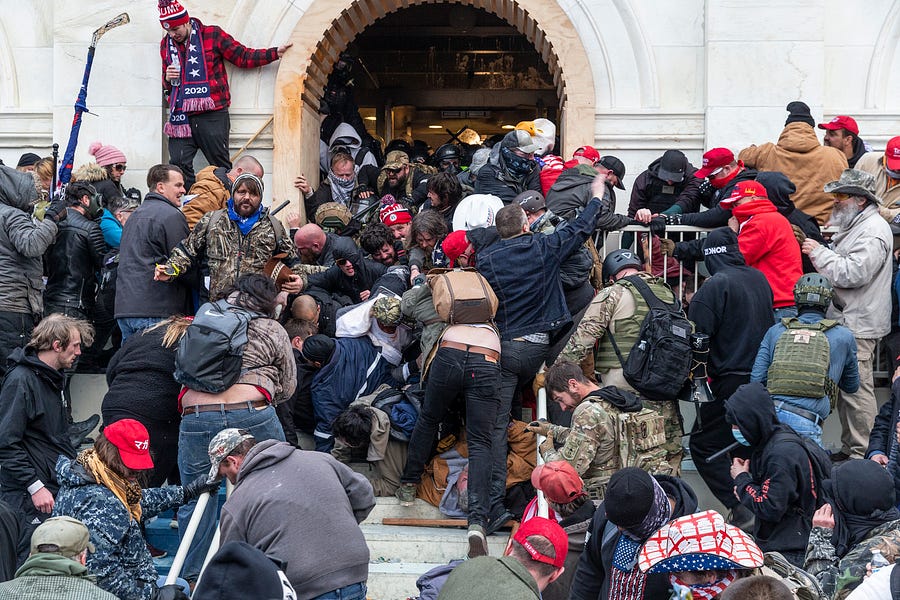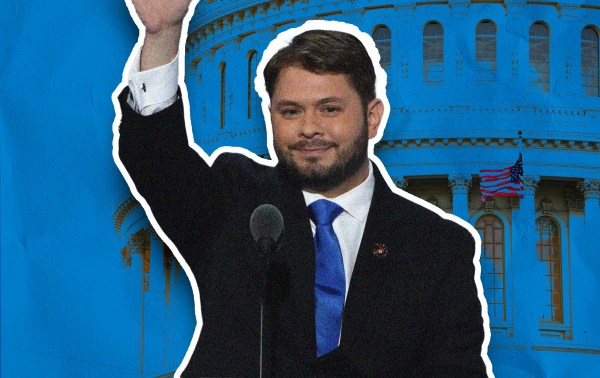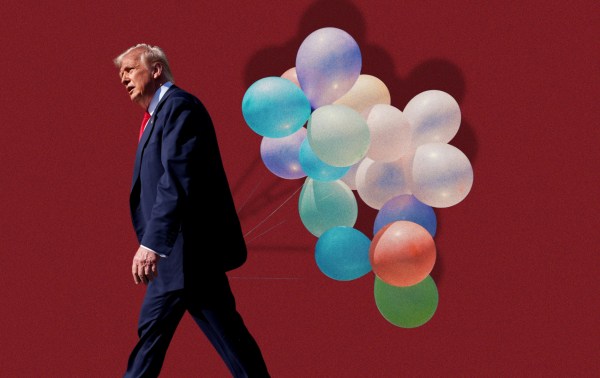In January 2008 I published my first book, Liberal Fascism.
It did well, reaching No. 1 on the New York Times and Amazon bestseller lists. It has been published in many languages. It was, to put it mildly, controversial and remains so to this day.
While I would certainly write the book differently today, I still stand by much of it, proudly so in many regards. For instance, I take great satisfaction that my hammer-and-tongs attack on Woodrow Wilson’s nativism, racism, and authoritarianism, much ridiculed at the time (the headline of the New York Times review of Liberal Fascism was a mocking “Heil Woodrow!”), is now much closer to conventional wisdom on the left and right.
But there’s one important claim that has been rendered utterly wrong. I argued that, contrary to generations of left-wing fearmongering and slander about the right’s fascist tendencies, the modern American right was simply immune to the fascist temptation chiefly because it was too dogmatically committed to the Founders, to constitutionalism, and to classical liberalism generally.
Almost 13 years to the day after publication, Donald Trump proved me wrong.
Academics tend toward needless complication when trying to define fascism. Roger Griffin defined it as “a genus of political ideology whose mythic core in its various permutations is a palingenetic form of populist ultra-nationalism.” Roger Eatwell argued that fascism’s “essence” is a “form of thought that preaches the need for social rebirth in order to forge a holistic-national radical Third Way.” Emilio Gentile defined fascism as “a mass movement, that combines different classes but is prevalently of the middle classes, which sees itself as having a mission of national regeneration, is in a state of war with its adversaries and seeks a monopoly of power by using terror, parliamentary tactics and compromise to create a new regime, destroying democracy.” Other definitions emphasize a fixation with manliness and struggle, cults of personality, obsession with conspiracies both foreign and domestic, and the decadence of liberal capitalism and democracy.
Break definitions like these down into a checklist and replay the events of January 6 and you’ll get writer’s cramp checking the various boxes, starting with Ali Alexander’s tweet at 1:13 a.m., “First official day of the rebellion.” A couple hours later, a leader of QAnon announced that Mike Pence was leading a coup to stab the president in the back and linked to a blog post calling for “the immediate arrest of [Pence], for treason.” The speakers at the Save America rally hit all the themes. John Eastman peddled his cockamamie Americanized version of “parliamentary” tactics to steal the election. Rudy Giuliani called for “trial by combat.” Mo Brooks asked the mob to “fight for America” and the crowd chanted, “Fight for Trump! Fight for Trump! Fight for Trump!”
“You’ll never take back our country with weakness,” the president himself told the crowd, “You have to show strength, and you have to be strong.”
While defenders of the president and his minions insist that this was yet another example of figurative talk being unfairly mistaken by detractors as literal talk, it’s worth emphasizing that many members of the crowd definitely took this talk both seriously and literally. That’s why they brought military gear, bear spray, zip ties, and even a gallows.
Moreover, while it’s fine to talk about how only a fraction of the crowd that marched on the Capitol was violent and that most were not incited by the president’s rhetoric, the march itself was speaking in the language of fascism. Read up on the March on Rome to understand the point.
Now, I know enough about fascist theory to provide all of the caveats you can think of and even some you probably can’t. Those academic definitions I mentioned above have their uses, but the truth is that people overthink fascism. For the left, fascism’s similarity to, and common roots with, other ideologies in the revolutionary tradition required ever more elaborate and abstract explanations for why fascism is a wholly distinct phenomenon from other violent and occasionally genocidal ideologies. It is distinct in the same way various flavors of communism are distinct from each other. German fascism was very different from Italian fascism, not least because Germans and Italians are very different.
But there is something we can call “generic fascism.” It’s undemocratic. It elevates struggle, strength, and fighting over argument and ideas. It glorifies martial rhetoric as the language of a deeper truth and a greater source of meaning. It splits the world into us and them, and claims a kind of gnostic insight into the true spirit of the authentic people. This is why it glorifies in mass protests (much like many other revolutionary movements) and the spectacle of intimidating throngs. It has contempt for bourgeois morality and constitutional and democratic norms – particularly when they are obstacles to the pursuit of power. Sometimes it takes traditional religion and reframes it as political ratification of its goals. It glorifies will, specifically the will to do what the weak and unmasculine defenders of democracy are unwilling to do. It’s conspiratorial, believing that powerful forces are driven by sinister ambitions to keep the authentic and deserving people down and divided. If your response to all of this is that this describes a lot of left-wing movements around the world and throughout history, my response is, “You’re right.” But also: “So what?”
One of the mistakes I made in Liberal Fascism was placing too much emphasis on intellectual history. I wrote:
For more than sixty years, liberals have insisted that the bacillus of fascism lies semi-dormant in the bloodstream of the political right. And yet with the notable and complicated exceptions of Leo Strauss and Allan Bloom, no top-tier American conservative intellectual was a devotee of Nietzsche or a serious admirer of Heidegger. All major conservative schools of thought trace themselves back to the champions of the Enlightenment—John Locke, Adam Smith, Montesquieu, Burke—and none of them have any direct intellectual link to Nazism or Nietzsche, to existentialism, nihilism, or even, for the most part, Pragmatism. Meanwhile, the ranks of left-wing intellectuals are infested with ideas and thinkers squarely in the fascist tradition. And yet all it takes is the abracadabra word “Marxist” to absolve most of them of any affinity with these currents. The rest get off the hook merely by attacking bourgeois morality and American values—even though such attacks are themselves little better than a reprise of fascist arguments.
This was true then and it’s still largely true now among conservatives who haven’t been swept up in the us-vs.-them passions that define the louder and uglier parts of the right. (Though it’s worth noting that there are segments of the right that now flirt with ideas once considered wholly outside the dogmas of American conservatism.)
But the truth is that often in politics, especially populist and revolutionary politics, ideas are lagging indicators. Lenin picked up and discarded various ideas like a mechanic rummaging through a messy tool box. So did Mussolini. So did Hitler.
My view is that generic fascism asserts itself as passion, not reason. Fascism is a highly concentrated and toxic form of populism that manifests itself as the politics of mobs, not manifestos. The ideological constructs used to defend and proselytize fascist ideologies were instrumental, not elemental, to the cause. Whether it was Hitler’s Führerprinzip or Mussolini’s Nietzschean pragmatism, even fascist intellectuals ultimately conceded that ideas were at best secondary considerations, mere marketing to give the naked pursuit of power more credibility and legitimacy.
On January 6, the president of the United States marshaled propaganda and lies to convince a mob that strength and will and violence were required to hold onto power. Sinister, faceless forces were conspiring against the people, and they needed to be confronted regardless of how much it offended the sensibilities of the weak and corrupt. Countless speakers invoked the language of rebirth and vowed to sweep the conspiratorial forces occupying our government. The Buffalo Helmet Viking Guy concluded his prayer in the Senate thus: “Thank you [God] for allowing the United States of America to be reborn. Thank you for allowing us to get rid of the communists, the globalists, and the traitors within our government.”
In the days leading up to January 6, Trump’s coterie, including his one-time national security adviser, raised the specter of martial law to set the nation right. This was in the wake of Trump exhausting all legal remedies in front of scores of judges – many of them conservative – who rejected the president’s often spurious claims. In the year since, the president and his defenders have constructed any number of “stabbed in the back” narratives about how they were robbed by sinister forces that are now using January 6 to oppress the authentic people. Some even try to make Ashli Babbitt into some kind of Horst Wessel-like martyr, a woman who was robbed of her life by the shadowy forces protecting our corrupt order. Countless right-wing populists today openly and unapologetically celebrate an event that marks the end of America’s tradition of the peaceful transfer of power. Sen. Josh Hawley wrote yesterday for Fox News that the “true legacy” of January 6 was “the Left’s attempt to use the Capitol unrest to foster a permanent climate of fear and repression.” Donald Trump insists that “the real insurrection” was Election Day.
When Jonathan Karl asked Donald Trump about the chants of “hang Mike Pence,” the former president brushed it off: “Well, the people were very angry.” That’s true! Mobs, pretty much by definition, are angry. It is a fascist trope to insist that the anger of a mob is self-justifying. More importantly, why was the mob angry? Because Trump lied to them. He lied to them for a specific purpose: to use a mob – or simply a huge mass of people – to intimidate the legislative branch into nullifying an election.
Now, you may think this isn’t fascism. And I’ve spent enough time arguing about fascism to imagine a dozen counterarguments that might have some merit. But you can’t convince me that this didn’t indefensibly move the Overton window in a fascist direction.
Like so much that defined the Trump years, January 6 represented the abandonment of the dogma that I believe immunized conservatism from the fascist temptation and rendered glib accusations of fascism at small-government conservatives so idiotic and slanderous. I believed that conservatism was too committed to the Constitution, to classical liberalism, to the rule of law, to tolerate the use of extralegal violence and mob intimidation. I still believe that those dogmas are a bulwark against fascism, or a tyranny that goes by any other name. What I no longer have faith in is the right’s commitment to those dogmas.
If you want to claim that fascism is right-wing, we can have that argument again. It certainly was in certain European contexts. But in America, at least until recently, the right was committed to Anglo-American definitions of conservatism that are definitionally antithetical to fascism. Remove those commitments and you remove the constraints against the spirit of fascism.
Call that spirit something else if you like. I don’t care. The labels matter less than the spirits they describe. And that spirit has nothing to do with conservatism rightly understood.







Please note that we at The Dispatch hold ourselves, our work, and our commenters to a higher standard than other places on the internet. We welcome comments that foster genuine debate or discussion—including comments critical of us or our work—but responses that include ad hominem attacks on fellow Dispatch members or are intended to stoke fear and anger may be moderated.
With your membership, you only have the ability to comment on The Morning Dispatch articles. Consider upgrading to join the conversation everywhere.